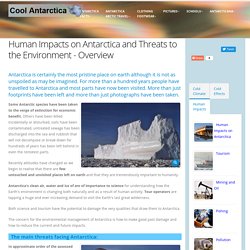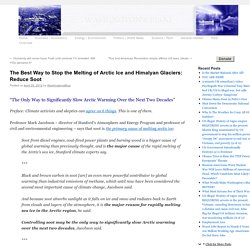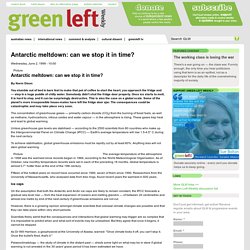

ContentServer.asp 3. 112817936. Global Warming. Arctic .pdf. What YOU Can Do About Climate Change. Earth Under Water Global Warming Future Disovery Documentary HD. Discovery Channel - Global Warming, What You Need To Know, with Tom Brokaw. Human Impacts on Antarctica and Threats to the Environment, scientific bases, tourists and tourism, fishing and fisheries, mining, oil exploration, and other potential perils. Antarctica is certainly the most pristine place on earth although it is not as unspoiled as may be imagined.

For more than a hundred years people have travelled to Antarctica and most parts have now been visited. More than just footprints have been left and more than just photographs have been taken. Some Antarctic species have been taken to the verge of extinction for economic benefit. Others have been killed incidentally or disturbed, soils have been contaminated, untreated sewage has been discharged into the sea and rubbish that will not decompose or break down for hundreds of years has been left behind in even the remotest parts. Recently attitudes have changed as we begin to realise that there are few untouched and unvisited places left on earth and that they are tremendously important to humanity. Antarctica's clean air, water and ice of are of importance to science for understanding how the Earth's environment is changing both naturally and as a result of human activity. Past Sins. The Best Way to Stop the Melting of Arctic Ice and Himalyan Glaciers: Reduce Soot.
“The Only Way to Significantly Slow Arctic Warming Over the Next Two Decades” Preface: Climate activists and skeptics can agree on 6 things.

This is one of them. Professor Mark Jacobson – director of Stanford’s Atmosphere and Energy Program and professor of civil and environmental engineering – says that soot is the primary cause of melting arctic ice: Soot from diesel engines, coal-fired power plants and burning wood is a bigger cause of global warming than previously thought, and is the major cause of the rapid melting of the Arctic’s sea ice, Stanford climate experts say.
Indeed, the ability of soot to melt snow and ice is so well-known that, in the 1970s, scientists – including Obama’s top science adviser – proposed pouring soot over the arctic to melt the ice and so prevent the ice age which scientists feared. Time Magazine wrote in 2009: Black carbon [another name for “soot”] in the air actually absorbs sunlight as it comes from space, directly heating up the atmosphere. Indeed, Dr. Antarctic meltdown: can we stop it in time? Wednesday, June 2, 1999 - 10:00 By Norm Dixon You stumble out of bed in bare feet to make that pot of coffee to start the heart, you approach the fridge and — step in a huge puddle of chilly water.

Somebody didn't shut the fridge door properly. Once ice starts to melt, it is hard to stop, and it can be surprisingly destructive. This is also the case on a global scale. The concentration of greenhouse gases — primarily carbon dioxide (CO2) from the burning of fossil fuels, as well as methane, hydrocarbons, nitrous oxides and water vapour — in the atmosphere is rising. Unless greenhouse gas levels are stabilised — according to the 2500 scientists from 80 countries who make up the Intergovernmental Panel on Climate Change (IPCC) — Earth's average temperature will rise 1.5-4.5° C during the next century. To achieve stabilisation, global greenhouse emissions must be rapidly cut by at least 60%. Antarctic Ice Melt Could Get Worse, But Humans Can Slow It Down.